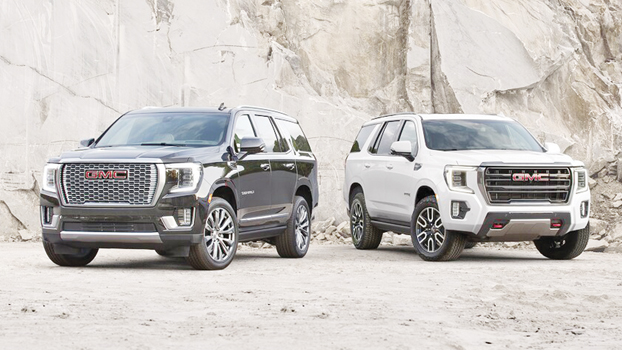2021 GMC Yukon has rivian-like “Hurricane Turn” spin feature

Startup electric carmaker Rivian recently dropped our jaws when it announced a "Tank Turn" function for its R1T pickup and R1S SUV, where the vehicles' left-side wheels spin in the opposite direction from the right-side wheels, enabling them to spin in place like a tank. Consider our jaws similarly felled by GMC's decision to include a similar capability, dubbed "Hurricane Turn," in the new 2021 Yukon SUV. (See more on Tank Turn here.)
There are, of course, a few key differences between the GMC system and Rivian's. The Rivian models are powered by four individually controlled electric motors, one per wheel, and can truly rotate around a central axis on a low-friction surface. (Watch the video below!) The Yukons are powered by a single engine each, which can drive either the rear wheels or—with four-wheel drive engaged—all four wheels. It probably goes without saying that, yes, at any given time those two-to-four GMC wheels are being spun in the same direction (either forward or backward).
So, how do the GMC Yukon's conventionally driven wheels help the vehicle spin? We weren't able to extract many details from GMC on this front—the engineers were hoping to keep a lid on the feature until a later date, so we did our best to pepper them with questions at the '21 Yukon's reveal event. Here's what we could surmise: "Hurricane Turn" functionality is engaged when the Yukon's electronic brain detects that the driver intentionally has done the following: Deactivates stability control, cranked the steering wheel hard to either the left or the right, and floored the gas.
If the truck is on a low-friction surface, such as snow or gravel, the system jumps into action, manipulating the brakes, particularly on the side you're steering toward (if you're steering to the right, then it grabs the right brakes, and vice versa) to instigate a sort of donut move. In this state, the GMC rotates around its front axle, like someone competing in one of those spin-around-a-baseball-bat-before-running competitions. Keep your foot on the throttle, and the GMC's "Hurricane Turn" system will gradually tighten the donut spin radius—a technical term we just made up—until the Yukon is nearly spinning around its central axis, like the Rivian.
Again, GMC was hardly forthcoming when we pressed for more details, both on the system itself and whether or not it'd be limited to the new-for-2021, off-road-specific AT4 trim. Our best guess? That the new Yukon's Active Response 4WD system full-time four-wheel-drive system (which can sort out front-rear torque splits on the fly) works in conjunction with the fancy brake applications and the new electronic limited-slip rear differential (which can direct engine torque side-to-side between the rear wheels) to afford enough individual control over the four tires to pull off a near-stationary spin.
Those spins might only be tropical storm level compared to the four-motor Rivians' cyclone effect, but consider us impressed that GMC figured out how to get most of the way there using only a good-ol'-fashioned V-8 engine and a little new-fashioned four-wheel drive. We're excited to try whipping the Yukon into a spinning frenzy for ourselves—we weren't able to try the system at GMC's launch event—and to delve deeper into the details, which are forthcoming.




